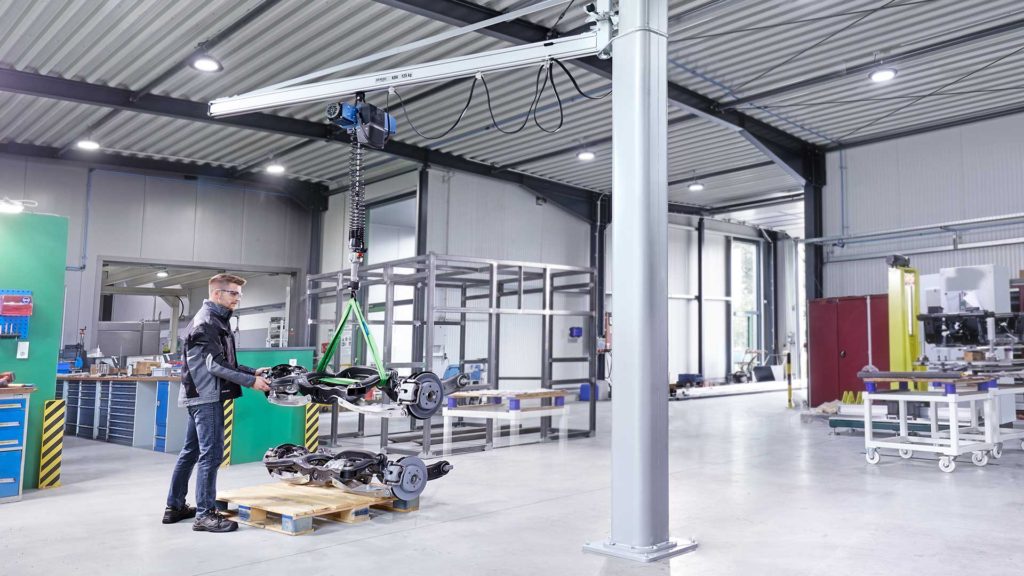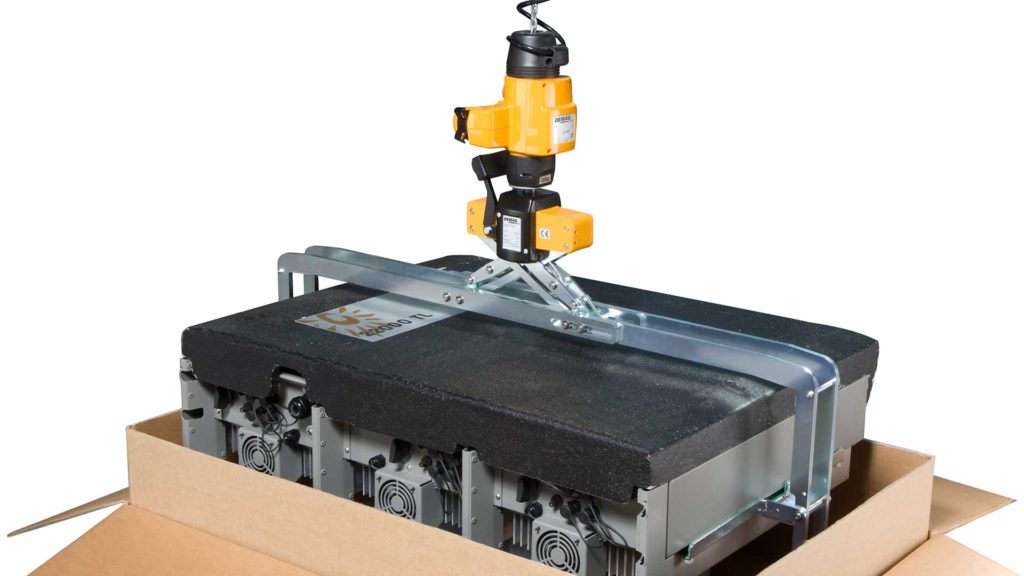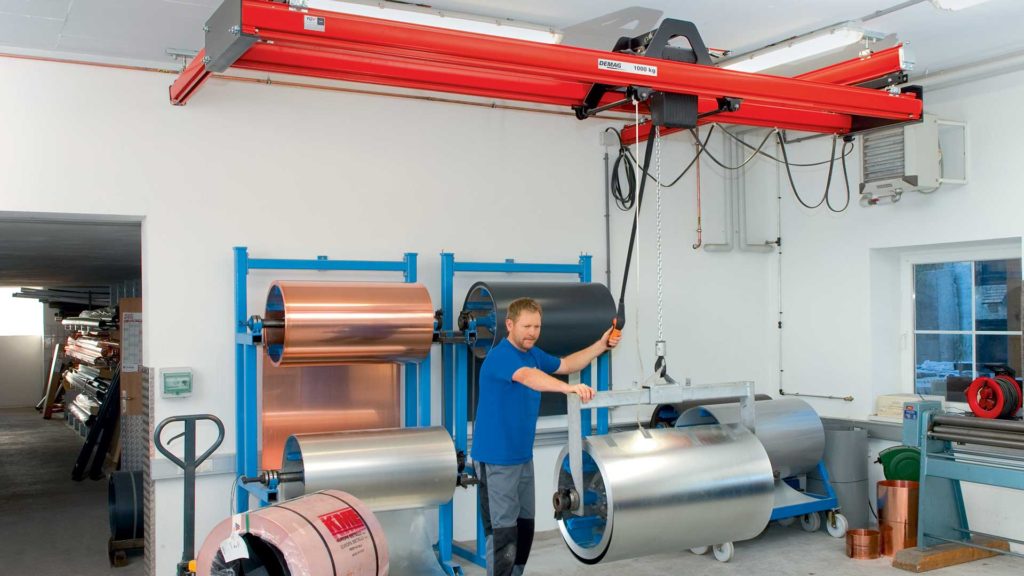There are endless ways to optimize assembly or manufacturing processes. When adding a lifting device to your processes, there are many considerations to find the solution that will fit your needs. If the task operators are performing is light weight, less than 1,000 pounds, and needs to be precise, adding an electric or air balancer can complement the operation. Balancers allow the load to float, making assembly tasks smoother and more precise. Today we are talking about the main considerations when choosing a balancer or chain hoist to compliment an assembly or manufacturing process in your facility.
How You Will Handle the Load

How an operator needs to handle a load is a major consideration when adding a lifting device like a chain hoist or electric or air balancer. Choosing between these two devices is dependent on how the load is handled, whether the operator needs 2 hands on the load at any point during the task or the operator can perform the necessary action with one or no hands on the load.
One of the major benefits gained with a balancer is the ability to use two hands on the load. This is especially true in assembly or manufacturing operations where precise positioning is needed. For instance, if an operator is assembling two components horizontally, he or she needs to be able to guide the load with two hands to find the correct positioning to connect the two parts. This task would be nearly impossible using a chain hoist where one hand uses the pendant control and the other would help with positioning. Balancers are specifically programmed to make precise positioning easy.
A chain hoist is an all-purpose lifting partner for operators. When the components you’re moving are heavy and need to be transported or lifted for a manufacturing process, this could be the right choice for you. Chain hoists allow operators to lift a load ergonomically and position a load for the next process. These hoists allow the operator to lift and move a load without a hand on the load or with one hand on the pendant and the other guiding the load.
You Need Custom Grippers to Handle Parts or Components

Many assembly processes require customized grippers attached to a lifting device. There are a wide range of manual and powered grippers that help handle different types of products. From round bar and boxes to specialized grippers for lifting customized parts, there is a gripper that can be made to help lift and handle nearly any component. Both chain hoists and balancers allow for interfacing custom grippers into the process. The most important aspect of this consideration is making sure the balancer or chain hoist can interface with the grippers you use.
Operator Movements to Perform the Job

How the operator moves or performs the task is a consideration when choosing a lifting device. As you are going through your options, you look at whether the device will be used inside or outside the comfortable reach of the operator. What comfortable reach can mean has to do with the task being performed and where the component is picked up and set down. Balancers allow the operator to handle a part within, or inside, comfortable reach. This can mean the operator needs to be very close to the load to precisely assemble one component onto another. The device used needs to allow for delicate movements and detect slight changes in motion while making the assembly process smooth. Another aspect to keep in mind is whether the load needs to travel on a trolley. Depending on how heavy the load is on the balancer, a manual or powered trolley can be used.
Chain hoists are great lifting tools for tasks outside of comfortable reach. If an operator needs to move a completely assembled engine from the area where it is assembled to a pallet, the operator doesn’t need to make precise, intricate movements to perform this task. The main aspects of this task are to lift, transport, and place the engine in an efficient, safe manner.
Capacity

When lifting a load with a chain hoist or balancer, the capacity is a major aspect of the decision. Due to the type of tasks performed by balancers, lower capacities are handled by balancers. The maximum capacity of balancers is approximately 770 pounds. If this capacity spectrum is within your needs, there are different types of balancers with different capacity limits. For instance, electric balancers handle a lower capacity, approximately 350 pounds, while air balancers, or pneumatic balancers, can handle a slightly higher capacity of approximately 770 pounds. Your facility may have a preference on whether to use an electric balancer or air balancer for the task. Making sure the selected balancer can meet your capacity needs is key.
Chain hoists can lift much higher capacities, up to 2 tons. A chain hoist can allow an operator to lift a load ergonomically and safely. Paired with a powered or manual trolley, this hoist can make lifting and handling heavier loads more efficient and effective.
Power Supply
The power supply preference of your manufacturing facility can make your lifting device decision straight forward. Chain hoists are commonly available as electric chain hoists. When it comes to balancers, electric and air balancers available. Each type of balancer has similar and unique benefits for operators. Electric balancers deliver power through standard voltage and power requirements found in manufacturing facilities in the USA and Canada. The Demag DCBS Electric Balancer has voltage options that will work outside of these markets but verifying the electrical requirements where the product is going is always critical. The DCBS gives benefits that you may be familiar with due to using a Demag DC chain hoist. As part of this product family, the DCBS delivers many of the same great features with the added benefit of balancing or floating loads.
Air balancers, or pneumatic balancers, use clean air as the power supply. The air works within the balancer to lift and lower the load. Many manufacturing facilities already run a clean air supply throughout so adding an air balancer can be a very easy decision to meet your needs. Air balancers, like the Demag D-BP II air balancer, eliminate the use of electrical power and compliments the operator’s movements as a task is performed.
Electric balancers and air balancers compliment assembly and manufacturing processes which can make these tasks more efficient and ergonomic. Chain hoists are an all-purpose lifting partner for operators that allow lifting tasks to be performed in a variety of processes. Balancers allow operators to float a load and position loads with precision not found in other lifting devices like chain hoists. As you evaluate the best decision for your processes, always work with an experienced manufacturer and dealer of lifting products so you can find the solution to meet your needs.
Learn more about Demag electric and air balancers on our website! https://www.demagcranes.com/en-us/products/hoist-units/balancers
